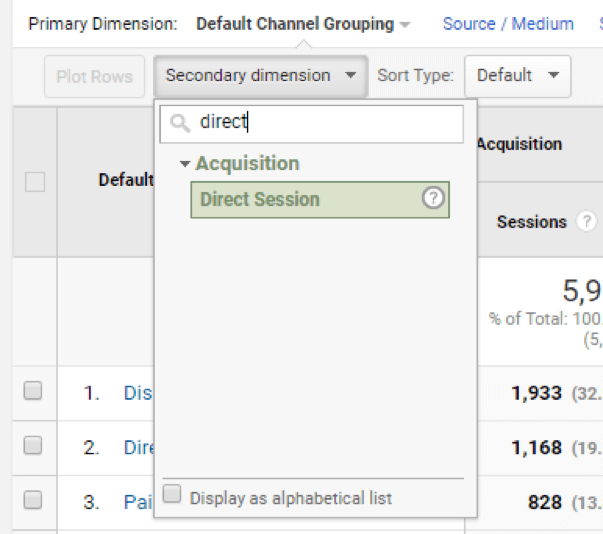Transform Your Analytics Strategy With Additional Measurement in Google Analytics
By integrating additional dimensions right into data evaluation, a brand-new layer of insights arises, losing light on complex customer habits and communications. The critical application of secondary dimensions holds the crucial to unlocking a treasure trove of indispensable information that can revolutionize how services translate and act upon their data.
Recognizing Second Dimensions in Google Analytics
Second dimensions in Google Analytics provide additional context to primary data by permitting users to examine metrics across a second dimension, supplying much deeper understandings into individual habits and interactions on a site. Secondary Dimension in Google Analytics. While main dimensions give essential information factors such as pageviews, bounce price, and session duration, second dimensions supply an even more comprehensive sight by segmenting the main data further. This segmentation enables individuals to evaluate metrics in mix with one more measurement, such as traffic sources, demographics, or customer habits
Advantages of Making Use Of Secondary Measurements
Utilizing additional measurements in Google Analytics uses a calculated advantage by enhancing the deepness of analysis and offering an extra thorough understanding of user interactions and behavior on a site. By incorporating secondary dimensions, analysts can obtain beneficial understandings right into the performance of certain sections or variables within their information. This enables a much more in-depth exam of user actions beyond surface-level metrics, enabling a deeper exploration of the factors affecting user involvement and conversions.

Exactly How to Implement Secondary Measurements
When incorporating secondary dimensions in Google Analytics, one vital action is to pick the pertinent metrics and dimensions to enrich the analysis procedure. Clicking on this button will certainly open up a drop-down food selection listing numerous dimensions that can be added to your key dimension for much deeper understandings.
After choosing the ideal second measurement, such as 'Source/Medium' or 'Gadget Group,' Google Analytics will certainly present the data in a more comprehensive format, enabling you to cross-analyze various elements of user habits. click to investigate Bear in mind to explore different mixes of additional and main dimensions to reveal valuable patterns and patterns that can educate your advertising techniques. By executing secondary dimensions attentively, you can get an extra comprehensive understanding of your website or app efficiency and make data-driven decisions to optimize your digital visibility.
Studying Data With Secondary Dimensions
Improve your information analysis in Google Analytics by integrating secondary dimensions to dig much deeper into customer behavior patterns and maximize your electronic advertising and marketing methods properly - Secondary Dimension in Google Analytics. By including second dimensions to your primary information, you can gain valuable understandings that can aid you make informed decisions concerning your website or application performance
Assessing data with second measurements enables you to section your primary information even more, offering an extra extensive view of individual interactions. For example, combining the main dimension of 'source/medium' with a second dimension like 'touchdown web page' can reveal which certain web pages are driving web traffic from different sources. This info can be critical in improving your content technique or optimizing your marketing campaign to boost conversions.
Moreover, making use of secondary dimensions enables you to more helpful hints determine correlations in between various metrics, helping you comprehend the influence of numerous aspects on customer behavior. Whether it's examining demographics along with individual engagement metrics or tool groups with conversion prices, second measurements empower you to reveal hidden trends and patterns that can assist your marketing initiatives.
Maximizing Performance With Secondary Measurements
To boost the effectiveness of information evaluation and decision-making in Google Analytics, incorporating second dimensions is crucial to maximizing performance metrics and gaining deeper understandings right into user actions patterns. By making use of secondary measurements, analysts can delve past surface-level data and reveal beneficial connections that might otherwise go unnoticed. This optimization method enables businesses to customize their marketing efforts better, determine locations for enhancement in web site usability, and improve total customer experience.
Additional measurements supply an even more thorough sight of individual communications by providing additional context to primary information metrics. Pairing the key dimension of 'landing web page' with a second measurement like 'tool classification' can reveal whether particular gadgets are a lot more most likely to drive engagement on details touchdown pages. This insight can notify responsive style improvements or targeted advertising strategies to improve performance.

Verdict
Finally, the integration of additional measurements in Google Analytics supplies companies with an effective device to enhance their analytics approach. Secondary Dimension in Google Analytics. By diving deeper right into individual actions and interactions, check out here marketers can uncover useful insights that can drive efficiency optimization and boost the overall user experience. Leveraging additional dimensions enables for an extra thorough evaluation of data, bring about more educated decision-making and customized marketing efforts
Additional measurements in Google Analytics give additional context to primary data by permitting customers to examine metrics throughout a 2nd measurement, using deeper insights into user actions and communications on a website. While main dimensions provide essential information factors such as pageviews, bounce rate, and session period, additional measurements use a more detailed view by segmenting the primary data additionally.One of the vital advantages of utilizing second dimensions is the capacity to uncover relationships and patterns that may not be immediately obvious when examining data with primary dimensions alone.When integrating additional dimensions in Google Analytics, one necessary step is to select the appropriate metrics and dimensions to enhance the analysis process. Combining the key dimension of 'landing page' with an additional measurement like 'tool category' can reveal whether specific tools are more most likely to drive engagement on certain landing web pages.